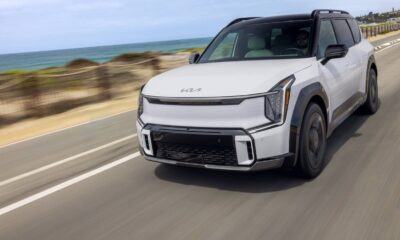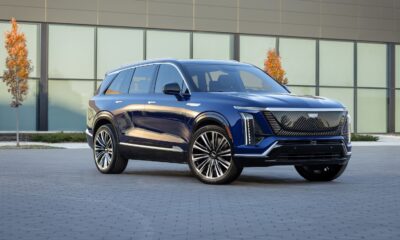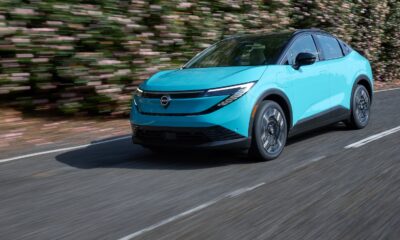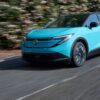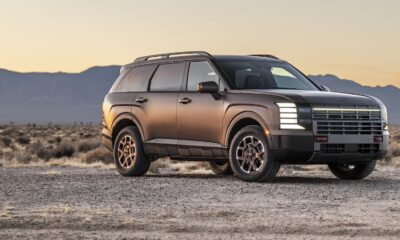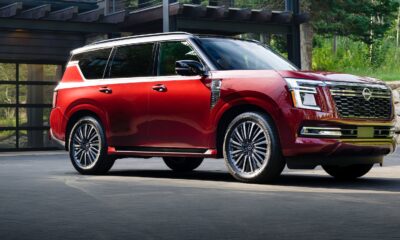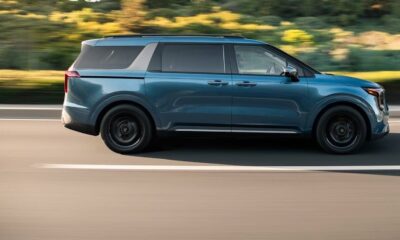Car Reviews
VOLVO’S EX30 EV – EX MARKS THE SPOT
VOLVO’S EX30 EV
EX MARKS THE SPOT
Finally, an EV that is fun to drive, reasonable to buy and cheap to operate.
Usually, my Sunday email tells me what I am driving the following week. Blonde Bride knows it is an electric car when she hears a mournful groan from my office.
Yes, I am among the 73% of Americans who understand that climate change is a thing, and that the single most significant contributor to the problem is transportation. I am a huge proponent of electric vehicles because they can make a massive change in air pollution and consumer economics.
The whole world, that is, you and I, can spend far less money getting from point A to point B and simultaneously give the planet a chance to heal, something the Creator programmed it to do.
You can figure this out for yourself. Track every dollar you spend on fuel, oil, and liquids for one month. Ask yourself what it would do to your monthly nut to divide that by seven or eight, especially given a reasonable monthly note. Welcome to your first day of automotive enlightenment.
As a test driver I don’t beat this drum loudly because, for me, it is false. An EV in the driveway means I will spend far more doing what I love that week. We live in flyover America, where recharging stations are sparse and pricey. Gas stations post prices, not charging stations, and if they did, we do not know what per what (watt?) would be a reasonable price.

The only way to make EV math work out is to do home charging. Most chargers now can plug into a 220 outlet and do Level 2 charging, but I do not have a spare 220 outlet in the garage. A 200-mile round trip to the mountains can easily cost $40 at a charging station, and the darn thing is about empty when I return.
Along comes Volvo’s compact EV, the EX 30, and it is powerful, nimble, quiet, and delivers the fuel range it promises when leaving the driveway (about 254 miles full). It will either provide a trickle charge (which batteries prefer) from a 110V outlet or Level 2 from a 220V outlet.
My tester arrived 80% charged, meaning it had about 180 miles in the tank (my shorthand for battery range). I had to take it somewhere, so I zipped out to the always beautiful Atlanta State Park. Toss in a few errands, and I burned off about 75 miles.
Blue-eyed Beauty’s plug-in hybrid resides in the garage, so that evening I ran a contractor-grade extension cord from the same plug that powers the freezer. I have tried this with other brands, but something in the hardware or firmware balked at the task. To my surprise, the Volvo hooked right up with happy little green lights flashing in all the right places. The next morning, it was right back up to 80%. I stayed in town the next two days. On the third morning, it was sitting at 100%. I grinned.
“Honey, I’m headed to the mountains.”
“Have a good time.”
She always tells me to have a good time, and I try to do what she says because it works out better. Still, at 74, I consider time spent observing, absorbing, and respecting the peace and eternal life of the forest to be more than good. It is a testimony to the power of prevenient grace.
When I returned, the little Volvo still had a 25% charge, which was 23% more than when I tried the same journey with a Chevrolet Equinox EV in March, which required a $43 Level 3 charge on the way out of town, and $35 more for the next few days. An Escalade would have done better.
People tend to focus on an EV’s range as a critical factor, but it is just a number. Quick, what is the range of your F-150? The issue will soon be wholly irrelevant with EVs. The first solid-state batteries, with ranges up to 500-700 miles, will go into production vehicles this fall. That is just one of multiple technological developments soon to be on the factory floor.
The real issue is, “How expensive and how much trouble is it to keep this thing on the road?” Sometimes I covered a sports event out of town in an EV and was unsure of making it home. Once, I did not and had to call for a rescue.
The answer lies in charging EVs at home. Swepco has some of the cheapest residential rates in the nation. Two-thirds of the miles Blonde Beauty puts on her car are all-electric, and the effect on the light bill has been negligible. Only solar charging would cost less.
The Volvo EX30 is the only pure electric I have tested that made me think,”Okay, this would work.”
Tariff? Oops
Four months ago, I was willing to label the Equinox EV, priced around $37,500, as the first EV for real people. The Hyundai Kona EV ($33-42,000) and Kia EV 3 ($35-50,000) also compete in this range. A dozen other models have strong global sales but are not in the U.S. market, which favors big things. Still, the sea is changing. A couple of years ago, the market only offered low-range runabouts or prohibitively expensive showcase pieces.
The EX30 was supposed to compete at the bottom of that price range, albeit without the soon-to-expire $7,500 U.S. tax credit the Chevy gets, but tariffs bumped the price 25%. That forced Volvo to drop the idea of a less-expensive single-motor version, thinking it would struggle as a value proposition. Instead, only a 422-hp, twin-motor AWD version, starting at $46,600, is available on these shores.
Tax incentives proved problematic. From a marketing standpoint, they told consumers there was something inherently wrong or weak about EVs. They felt like a bribe. Buyers did not get the money anyway. The month after the credits went into place, manufacturers bumped prices $5,000 to $7,000.
In Europe, where most EV tax credits expired at the beginning of this year, EV sales are up 33% for the first six months. Every manufacturer saw double-digit gains in Europe except Tesla, which fell 50%. Volvo’s EV sales jumped 14% in the first half of this year, and a big reason was the EX30, which makes sense. The car is a perfect mid-premium urban runabout on a continent where streets are smaller, distances are shorter, nimble handling and parking-lot niftiness are valued, and solar panels are common.
The denominator in the cost of ownership is years of longevity. After growing up with internal combustion engines, we are impressed when a vehicle lasts 250,000 miles. With electrics, think millions of miles. An electric driveline has fewer than 50 parts. An engine and transmission will have 3,000.
What about batteries? Plenty of 20-year-old hybrids are on the road running on their original set, and independent shops will replace a set at a fraction of a new gas or diesel motor.
Fun cars
Europeans value power, handling, crisp engineering, premium materials, and craftsmanship, and the EX 30 shines here. It blends Swedish engineering excellence and Nordic minimalist styling with a Porsche vibe.
Reviewers agree the EX30’s power is intoxicating for its size, with instant torque and brisk launches. It rockets from zero to 60 in 3.4 seconds, and 60-100 comes quickly, too. The suspension has some give, but steering feedback is crisp. The car has great stick, made even better by an AWD that digitally vectors torque to individual wheels to keep all glued to the road.
On the other hand, driven within spitting distance of the speed limit, the baby Volvo is delightfully efficient and charming. A Harmen-Karden sound system lends a luxury air to cruising through the mountains.
The cabin is Spartan, but altogether pleasant. Concave door panels and reduced-width armrests leave front passengers feeling they are traveling in business class. However, more supportive seats might build the premium feel at this price point.
A large 12.3-inch touchscreen, transparent vertical vents, recycled materials like flax composite, and a panoramic sunroof make the miles roll by. However, the lack of physical buttons means most functions—like climate control or glovebox access—are screen-based, prompting comparisons to Tesla, not in a good way. At the same time, the touchscreen-centered layout requires a learning curve.
Outside, the car has a quality look. It translates Volvo’s upscale, Scandinavian design philosophy into a compact footprint. Strong use of angular LED lighting, clean surfaces, and accent details—such as blacked-out spoilers and floating mirrors—offers a fresh aesthetic.
The Volvo EX30 offers a robust network of safety systems that use radar, ultrasonic sensors, and cameras to support predictive intervention and safer urban driving. All help it excel at quick merging, highway passing, and the ability to park and maneuver in tight urban areas.
Bottom line
For those ready for a smaller, safer, less expensive way to travel, the Volvo EX30 is a wise play.




